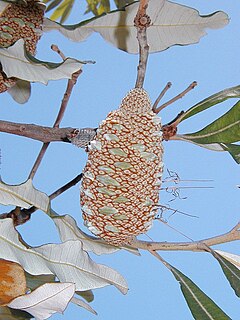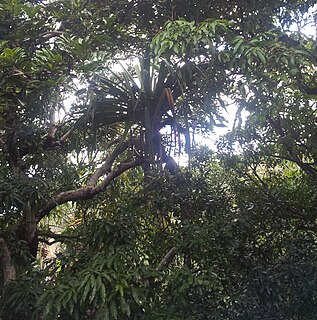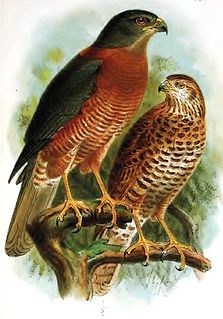
Pandanus is a genus of monocots with some 750 accepted species. They are palm-like, dioecious trees and shrubs native to the Old World tropics and subtropics. The greatest number of species are found in Madagascar and Malesia. Common names include pandan, screw palm, and screw pine. They are classified in the order Pandanales, family Pandanaceae.

Pandanus tectorius is a species of Pandanus (screwpine) that is native to Malesia, eastern Australia, and the Pacific Islands. It grows in the coastal lowlands typically near the edge of the ocean. Common names in English include thatch screwpine, Tahitian screwpine, hala tree, pandanus, and pu hala in Hawaiian. The fruit is sometimes known as hala fruit.

Banksia dentata, commonly known as the tropical banksia, is a species of tree in the genus Banksia. It occurs across northern Australia, southern New Guinea and the Aru Islands. Growing as a gnarled tree to 7 m (23 ft) high, it has large green leaves up to 22 cm (8.7 in) long with dentate (toothed) margins. The cylindrical yellow inflorescences, up to 13 cm (5.1 in) high, appear over the cooler months, attracting various species of honeyeaters, sunbirds, the sugar glider and a variety of insects. Flowers fall off the ageing spikes, which swell and develop follicles containing up to two viable seeds each.
Pandanus pyramidalis is a species of plant in the family Pandanaceae, endemic to Mauritius.

Ribes sardoum, commonly called Sardinian currant, is a species of plant in the gooseberry family. It is endemic to Italy, found only on the island of Sardinia.
Harold St. John was a professor of botany at the University of Hawaiʻi at Mānoa from 1929 to 1958. A prolific specialist in field botany and systematics, he is credited with discovering about 500 new species of Pandanus, along with many other species, especially in the Pacific Islands.
Pandanus elatus is a dioecious tropical plant in the screwpine genus. It is endemic to Christmas Island, an Australian territory in the north-eastern Indian Ocean. Its specific epithet comes from the Latin elatus (tall), in reference to its growth habit.
Ugolino Martelli (1860–1934) was an Italian botanist, biologist, and mycologist. Martelli is known for his studies of and contributions to the systematics of the tropical genus Pandanus and his taxonomic definition of the flora of Sardinia. He also specialized in studies of the flora of Tuscany and Malaysia.

Pandanus forsteri , commonly known as forky-tree or forkedy-tree, is a flowering plant in the screwpine family. The specific epithet honours either Johann Forster or Georg Forster, father and son German botanists, who accompanied James Cook as naturalists on his second voyage (1772–1775).

The vascular plant flora of the Cocos (Keeling) Islands consists of approximately 61 species native to the 22 vegetated islands and about 69 introduced species, most of which are confined to the two larger inhabited islands, Home Island and West Island. There are no plant species endemic to the islands; however, one variety of Pandanus tectorius is only found growing on these islands. The native vegetation of the two atolls primarily consists of sea-dispersed shoreline plants of the Indo-Pacific region. On the lagoon shoreline, tall shrublands are dominated by Pemphis acidula and Cordia subcordata, often growing in monospecific stands. Closed forest stands are dominated by either Cocos nucifera or Pisonia grandis.

Pandanus vandermeeschii is a species of plant in the family Pandanaceae. It is endemic to the coastal areas of Mauritius.

Pandanus iceryi ("Vacoas") is a species of plant in the family Pandanaceae. It is endemic to Mauritius.

Pandanus heterocarpus is a species of plant in the family Pandanaceae. It is commonly called the "Rodrigues screwpine", known locally as "vacoa parasol" or "vacoa cale rouge". It is endemic to the island of Rodrigues.

Pandanus eydouxia is a species of plant in the family Pandanaceae, endemic to Mauritius.

The karuka is a species of tree in the family Pandanaceae and an important regional food crop in New Guinea. The nuts are more nutritious than coconuts, and are so popular that villagers in the highlands will move their entire households closer to trees for the harvest season.

Pandanus dubius, commonly known as bakong or knob-fruited screwpine, is a species of Pandanus (screwpine) native to Island Southeast Asia, New Guinea, and the Western Pacific islands, and possibly also to the Andaman and Nicobar Islands.
Pandanus whitmeeanus, commonly known as the Samoan pandanus, is a species of Pandanus (screwpine) believed to be native to Vanuatu. It has been introduced to Samoa, Tonga, the Cook Islands, and the Hoorn Islands by Austronesian voyagers. It is also known in Samoan and Tongan as ‘ara ‘āmoa or paogo.

The wildlife of Christmas Island is composed of the flora and fauna of this isolated island in the tropical Indian Ocean. Christmas Island is the summit plateau of an underwater volcano. It is mostly clad in tropical rainforest and has karst, cliffs, wetlands, coasts and sea. It is a small island with a land area of 135 km2 (52 sq mi), 63% of which has been declared a National park. Most of the rainforest remains intact and supports a large range of endemic species of animals and plants.
Pandanus aridus is a species of shrub or small tree in the family Pandanaceae. It is native and endemic to Madagascar, found in fragmented locations in the southern third of the country. Pandanus aridus H. St. John is the accepted name, with a synonym of Pandanus toliarensis Huynh.
Pandanus dauphinensis a species of plant in the family Pandanaceae. It is native to coastal southeast Madagascar. Some references list Pandanus concretus as the accepted name, with numerous synonyms, including Pandanus centrifugalis, P. dauphinensis, P. erectus and P. madagascarensis. Panadus dauphinensis has cylindric complex fruits (syncarps) 18-20 cm long, and relatively broad leaves 12 cm or more in width with strong cross veining on the upper surface, including near the tip.













